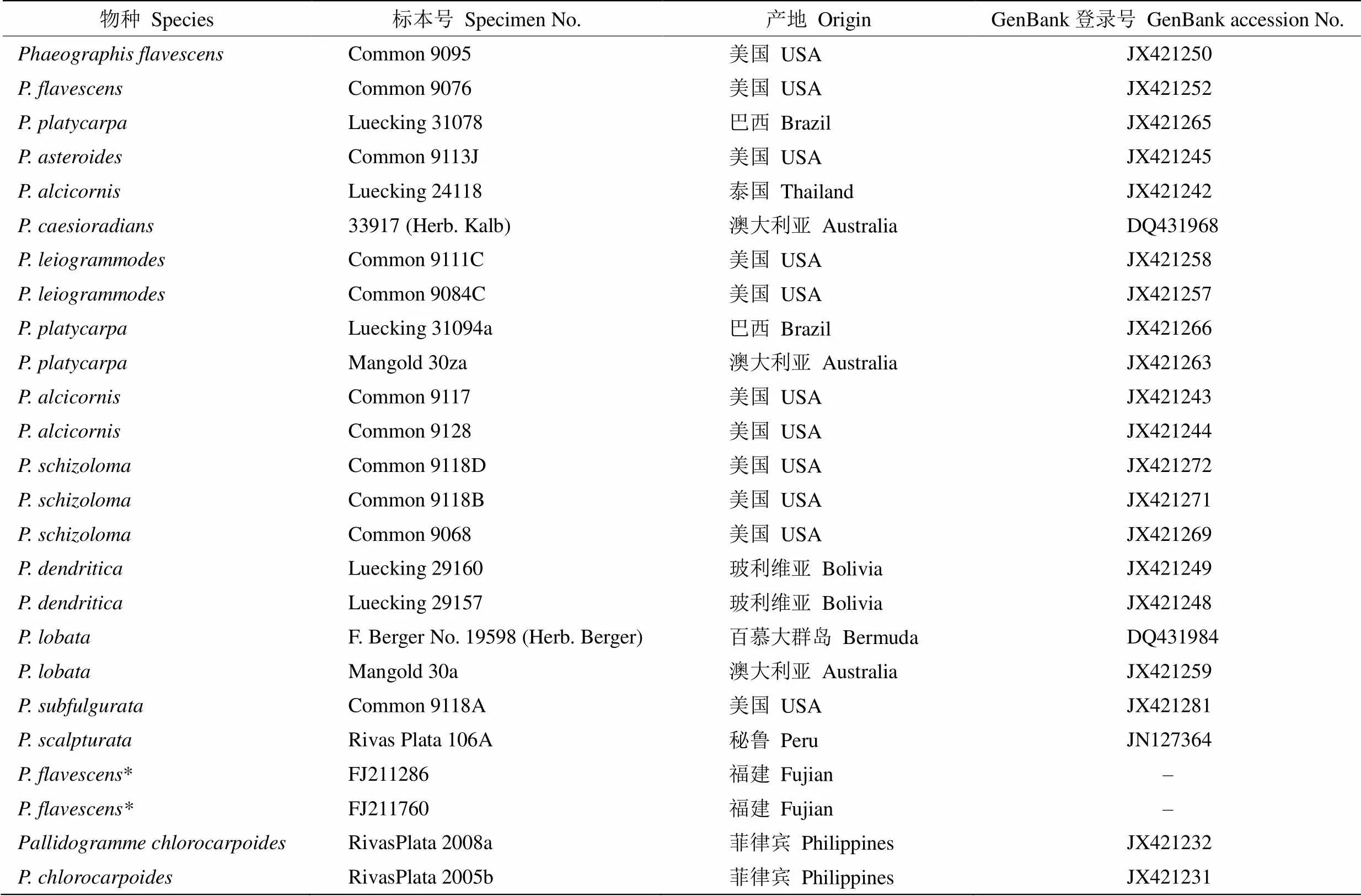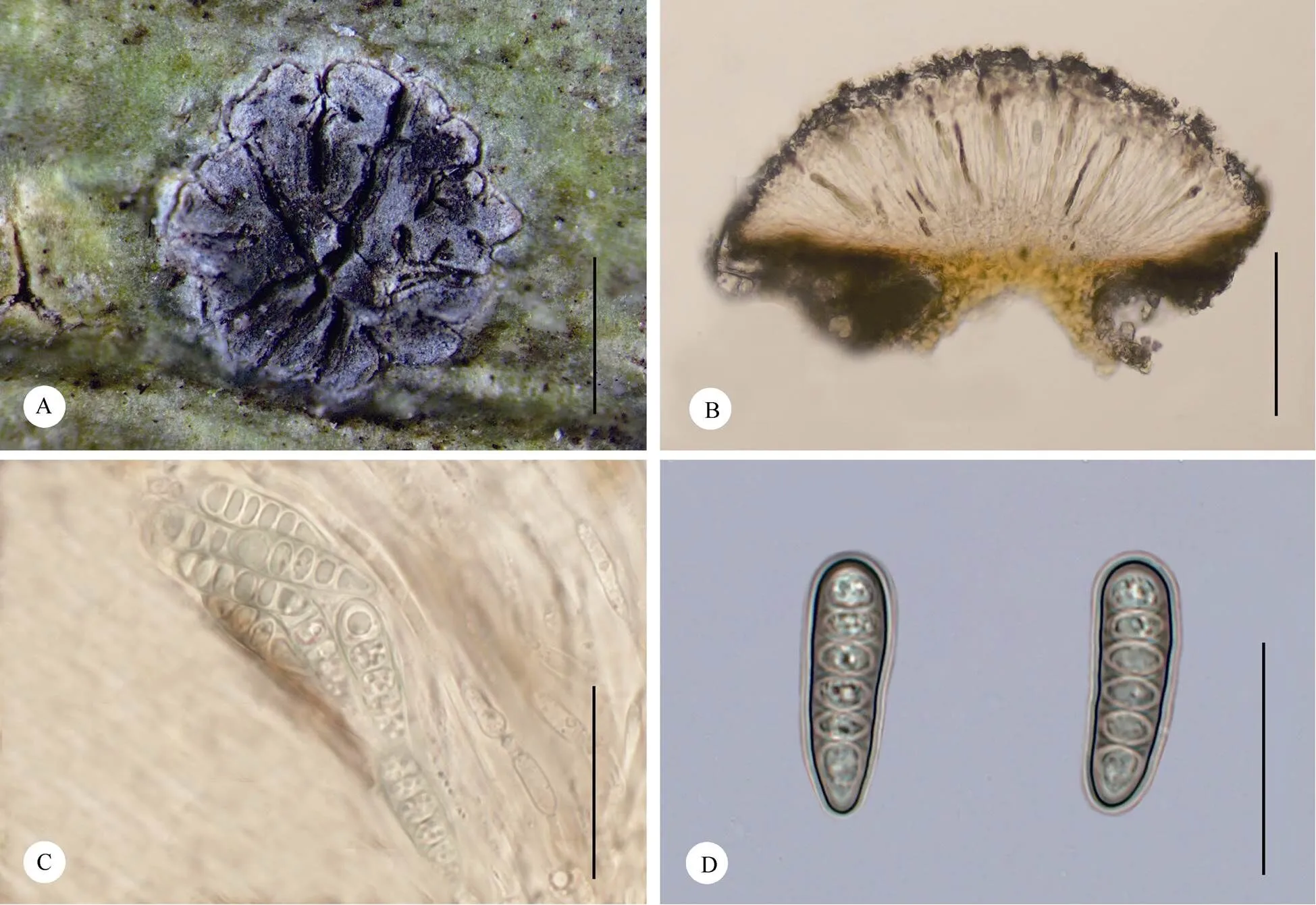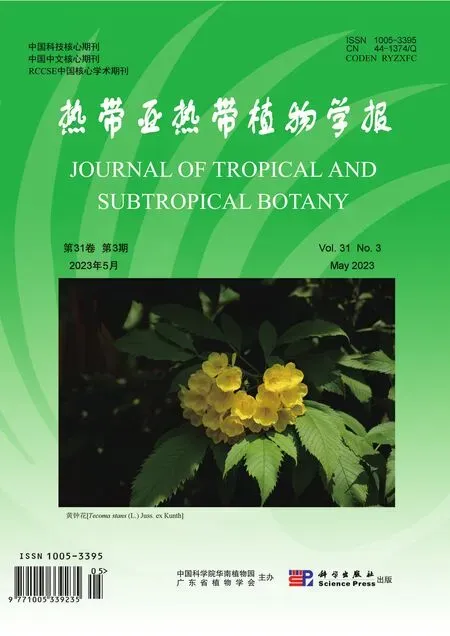变黄黑文衣, 中国黑文衣属地衣一新记录种
陈乐雯,何宣宣,贾涛,贾泽峰
变黄黑文衣, 中国黑文衣属地衣一新记录种
陈乐雯,何宣宣,贾涛,贾泽峰*
(聊城大学生命科学学院,山东 聊城 252059)
通过对文字衣科黑文衣属形态学、解剖学、化学与分子生物学的研究,发现中国新记录种1种,即变黄黑文衣(Dal-Forno & Eliasaro),该种主要特征为地衣体壳状,表面浅黄绿色,无光泽,光滑;子囊盘弯曲,多分支,聚生于假子座中;盘缘黑色,相邻线盘之间有小缝隙,盘面较平坦,黑色,覆有白色粉霜;子囊层无色透明,侧丝顶端分支;子囊含8个子囊孢子;子囊孢子褐色,横隔透镜型,(4~)6胞室,大小19~25.5m×6~7m,I+紫红色。该种分布于云南和福建,该研究丰富了对中国黑文衣属物种组成与分布的认知。
厚顶盘目;文字衣科;地衣型真菌;分类学
1882年,Müller Arg.综合运用显微技术与化学分析方法,基于孢子褐色且细胞横向排列的特征,以(Ach.) Müll. Arg.作为模式种建立黑文衣属(Müll. Arg.)。Staiger结合分子生物学方法,对Müller Arg.的分类系统进行修正,承认并重新定义黑文衣属[1]。
该属为泛热带分布,隶属于真菌界(Fungi)子囊菌门(Ascomycota)茶渍纲(Lecanoromycetes)厚顶盘亚纲(Ostropomycetidae)厚顶盘目(Ostropales)文字衣科(Graphidaceae)[2]。该属主要特征为地衣体壳状,表面蜡质或粗糙;子囊盘伸长为线状,弯曲或具有分支,少数聚生为类似子座结构;盘唇张开, 大多覆有白色粉霜;盘被不炭化至轻微炭化;子囊含8个孢子;子囊孢子褐色,横隔凸透镜型或砖壁型;共生藻为橘色藻属(sp.)[3–4]。
目前世界范围内报道黑文衣属约230种,中国仅报道25种[5–10]。因此,有必要对我国黑文衣属类群进行进一步研究,为我国地衣型真菌物种资源开发及利用提供基础资料。
1 材料和方法
1.1 材料
本研究标本采自福建、云南,现馆藏于聊城大学生命科学学院地衣标本室(LCUF)。
1.2 表型分析
使用体视显微镜OLYMPUS SZX16观察地衣体外部形态特征,光学显微镜OLYMPUS BX53观察解剖特征。通过滴加10% KOH溶液、NaClO饱和水溶液、P溶液(将对苯二胺溶于无水乙醇,配成5%乙醇溶液)、碘液观察颜色反应,薄层层析法(TLC)对地衣化学物质进行鉴定[11–12]。
1.3 基因型分析
DNA提取、PCR扩增、测序 使用Sigma- Aldrich REDExtract-N-AmpTM植物PCR试剂盒从子囊盘中提取基因组DNA,并采用引物mtSSU1与mtSSU3R对线粒体小亚基片段进行扩增[13]。PCR体系总体积为50L:2×PCR master mix 25L,ddH2O 19L,引物各2L,基因组DNA 2L;扩增程序为:95 ℃预变性5 min;然后94 ℃变性45 s,50 ℃退火1 min,72 ℃延伸90 s,共35个循环; 最后72 ℃延伸10 min。PCR完成后,用1%琼脂糖凝胶电泳检测目的产物,并由铂尚生物技术(上海)有限公司测序。序列信息见表1。

表1 系统发育分析所用标本信息和GenBank登录号
*: 新测序列。下同
*:New sequence. The same below
构建系统发育树 通过SeqMan对原始序列进行拼接处理,选择与黑文衣属亲缘关系较近的灰线衣属为外类群,在NCBI网站上下载所需的23条相关序列。将上述序列在BioEdit v. 7.0.5中利用最大似然法(Maximum-likelihood, ML)进行多序列比对及优化[14–15],在Cipres Science Gateway (http://www.phylo.org)使用RAxML-HPC BlackBox v. 8.2.12构建系统发育树[16–17],对各节点进行1 000次重复以评价自展支持值,获得的系统发育树文件在FigTree v. 1.4.2中查看和编辑(图1)。

图1 基于SSU序列构建的黑文衣属系统发育树
2 结果和讨论
变黄黑文衣 图2
Dal-Forno & Eliasaro, Mycotaxon 112: 16(2010)
Type: Brazil, Paraná: Pontal do Paraná. Pontal do Sul, 28. II. 2008, M. Dal-Forno 433 (Holotype UPCB).
地衣体壳状,树皮生,表面浅黄绿色,无光泽,光滑。
子囊盘弯曲,多分支,长0.5~1 mm,宽0.4~ 0.5 mm,聚生于假子座中,假子座圆形至不规则卵圆形;盘缘黑色,相邻线盘之间有小缝隙;盘唇不明显,张开;盘面较宽,平坦,黑褐色,覆有白色粉霜;盘被未炭化,褐色,厚8~18m;囊层被黑色,厚15~20m;子囊层无色,清晰状,厚80~90m;囊层基黄色,厚30~38m;侧丝具有横隔,顶端分支,宽1.0~1.5m;子囊棒状,含8个子囊孢子;子囊孢子褐色,卵圆形,横隔透镜型,(4~)6胞室,大小19~25.5m×6~7m,I+紫红色。
化学反应:K+浅黄色,C–,KC+浅黄色,P–;含有斑点酸 (TLC)。
基物:树皮。

图2 Phaeographis flavescens (L.W. Chen FJ211760)。A: 地衣体和子囊器; B: 子囊盘横切面; C: 子囊; D: 子囊孢子。标尺: A=1.0 mm; B=200 μm; C=20 μm; D=20 μm
研究标本:云南:西双版纳,勐海县,哈尼文化园,海拔1 190 m,2015年12月14日,贾泽峰YN15061 (LCUF)。福建:武夷山,桐木村,三港,海拔720 m,2021年10月22日,贾泽峰FJ211286 (LCUF);武夷山国家公园科技楼附近,海拔700 m,2021年10月24日,贾泽峰FJ211741 (LCUF),陈乐雯,FJ211759、FJ211760、FJ211761、FJ211763、FJ211764、FJ211765、FJ211766 (LCUF)。
世界分布:巴西[18];中国福建、云南。
讨论:根据分子数据分析,该种与属其他物种明显分开,且与聚为一独立分支,支持值高达98%,综合以上特征鉴定为。本研究标本与模式标本(Brazil)特征基本一致,但假子座颜色相对更浅,呈白色;另外,本研究只检测出斑点酸,而模式标本描述中还含有其他微量未知酸。其分类特征类似于Redinger.,后者子囊盘灰白色,弯曲,不规则分支,聚集为星状,孢子4~6室,但地衣化学物质不同, 含有新三锥酸[19]。该种形态学特征与(Nyl.) Müll. Arg.相似,不同之处在于后者子囊盘呈放射状或大量不规则分支,线盘较细长, 盘面在发育后期常发生汇合,从而形成较宽的中部区域;I+红褐色,含降斑点酸[20–21]。该种与Redinger.也较相似,不同之处在于后者子囊孢子较小,(12~)15~18m[22]。
[1] STAIGER B, KALB K, GRUBE M. Phylogeny and phenotypic variation in the lichen family Graphidaceae (Ostropomycetidae, Asco- mycota) [J]. Mycol Res, 2006, 110(7): 765–772.doi: 10.1016/j.mycres. 2006.05.003.
[2] WIJAYAWARDENE N N, HYDE K D, RAJESHKUMAR K C, et al. Notes for genera: Ascomycota [J]. Fung Diver, 2017, 86: 1–594. doi: 10.1007/s13225-017-0386-0.
[3] STAIGER B. Die flechten familie Graphidaceae studien in richtungeiner natürlicheren gliederung [J]. Bibliotheca Lichenol, 2002, 85: 1–526.
[4] LÜCKING R. Foliicolous Lichenized Fungi: Flora Neotropica Monograph 103 [M]. New York: The New York Botanical Garden Press, 2008: 1–867.
[5] WANG X H, SHI G B, JIA Z F., a new species of lichen [J]. Mycosystema, 2013, 32(1): 128–130. [王晓华,师广波,贾泽峰. 黑文衣属地衣一新种——福建黑文衣[J]. 菌物学报,2013,32(1): 128–130. doi: 10.13346/j.mycosystema.2013.01.016.]
[6] LI J, MIAO X L, JIA Z F. Additional materials for the genusfrom China [J]. J Fungal Res, 2014, 12(2): 79–82.doi: 10. 13341/j.jfr.2014.2008.
[7] JIA Z F, WEI J C. Flora lichenum Sinicorum, Vol. 13 Ostropales (I) Graphidaceae (1) [M]. Beijing: Science Press, 2016: 1–210. [贾泽峰, 魏江春. 中国地衣志, 第13卷厚顶盘目(I) 文字衣科(1) [M].北京: 科学出版社, 2016: 1–210.]
[8] JIA Z F, LÜCKING R. Resolving the genusMüll. Arg. in China [J]. MycoKeys, 2017, 21: 13–32. doi: org/10.3897/mycokeys. 21.11986.
[9] JIA Z F, LÜCKING R. Resolving the species of the lichen genusMüll. Arg. in China, with some new combinations [J]. MycoKeys, 2017, 25: 13–29. doi: org/10.3897/mycokeys.25.13154.
[10] WEI J C. An enumeration of lichens in China [M]. Beijing: China Forestry Publishing House, 2020: 1-606.
[11] CULBERSON C F. Improved conditions and new data for identifi- cation of lichen products by standardized thin-layer chromatographic method [J]. J Chromatogr A, 1972, 72(1): 113–125. doi: 10.1016/0021- 9673(72)80013-X.
[12] ORANGE A, JAMES P W, WHITE F J. Microchemical methods for the identification of lichens [J]. British Lichen Soc, London, 2001: 1–101.
[13] ZOLLER S, SCHEIDEGGER C, SPERISEN C. PCR primers for the amplification of mitochondrial small subunit ribosomal DNA of lichen- forming ascomycetes [J]. Lichenologist, 1999, 31(5): 511–516.
[14] THOMPSON J D, HIGGINS D G, GIBSON T J. CLUSTAL W: Improving the sensitivity of progressive multiple sequence alignment through sequence weighting, position specific gap penalties and weight matrix choice [J]. Nucl Acid Res, 1994, 22(22): 1673–1680. doi: 10. 1093/nar/22.22.4673.
[15] HALL T A. BioEdit: A user-friendly biological sequence alignment editor and analysis program for Windows 95/98/NT [J]. Nucl Acid Sym, 1999, 41(2): 95–98. doi: 10.1021/bk-1999-0734.ch008.
[16] MILLER M A, PFEIFFER W, SCHWARTZ T. Creating the CIPRES Science Gateway for inference of large phylogenetic trees [C]// Proceedings of the Gateway Computing Environments Workshop (GCE), LA: New Orleans, 2010: 1–8.
[17] STAMATAKIS A. RAxML version 8: A tool for phylogenetic analysis and post-analysis of large phylogenies [J]. Bioinformatics, 2014, 30(9): 1312–1313. doi: 10.1093/bioinformatics/btu033.
[18] DAL-FORNO M, ELIASARO S. Two new species of Graphidaceae (lichenized Ascomycota) from Brazil [J]. Mycotaxon, 2010, 112(1): 15–20. doi: 10.5248/112.15.
[19] REDINGER K. Die Graphidineen der ersten Regnell’schen Expedition nach Brasilien 1892–94. Ⅲ.und, nebst einem Nachtrage Zu[J]. Ark. Bot, 1935, 27A (3): 1–103.
[20] BUNGARTZ F, LÜCKING R, APTROOT A. The family Graphidaceae (Ostropales, Lecanoromycetes) in the Galapagos Islands [J]. Nova Hed- wig, 2010, 90(1/2): 1–44. doi: 10.1127/0029-5035/2010/0090-0001.
[21] ARCHER A W. The lichen genera,,,,,and(Graphidaceae) in Australia [J]. Telopea, 2004, 10(2): 589–605.
[22] REDINGER K. Die Graphidineen der ersten Regnell’schen Expedition nach Brasilien 1892–94. I.,und[J]. Ark Bot, 1933, 25A(13): 1–20.
, A New Record of the Lichen Genusin China
CHEN Lewen, HE Xuanxuan, JIA Tao, JIA Zefeng*
(College of Life Sciences, Liaocheng University,Liaocheng 252059, Shandong, China)
Based on the methods of morphology, anatomy, chemistry and molecular,Dal-Forno & Eliasaro (Graphidaceae) is recorded as new to China. It is characterized by crustose thallus, surface pale yellowish green, dull, smooth; ascomata flexuose, branched, immersed in pseudostromata; the lirellae have a narrow, brown-black edge, with small lateral cracks; disc flat, black, with white pruina; hymenium colorless, paraphyses with branched tips; ascospores 8 per ascus, brown, with transverse septa, (4–)6 locular, 19–25.5m× 6–7m, I+ wine-red. The species is found in Yunnan and Fujian provinces, and the study enriches our understanding of thecomposition and distribution in China.
Ostropales; Graphidaceae; Lichenized fungi; Taxonomy
10.11926/jtsb.4625
2022–02–24
2022–03–09
国家自然科学基金项目(31750001)资助
This work was supported by the National Natural Science Foundation of China (Grant No. 31750001).
陈乐雯(1997年生),女,硕士研究生,研究方向为地衣生物学,E-mail: 978064405@qq.com
. E-mail: zfjia2008@163.com

